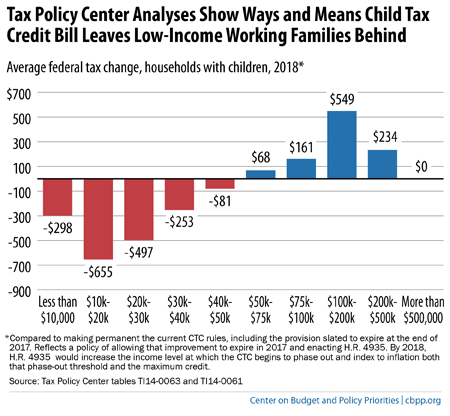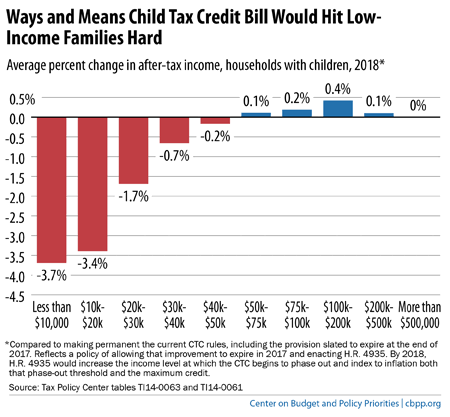más allá de los números
House Should Reject Backwards Child Tax Credit Bill
The full House next week will consider the Ways and Means Committee’s recently passed Child Tax Credit (CTC) bill. A recent Tax Policy Center (TPC) analysis confirms our previous critical assessments of the proposal, finding that it would make many relatively affluent people better off while making low-income working families poorer.
As we explained, the bill makes three main policy decisions that, taken together, constitute poor policy:
- It extends the Child Tax Credit higher up the income scale — on a permanent basis — so more families with six-figure incomes will benefit. The bill raises the income levels at which the CTC begins to phase out. (It also indexes those thresholds to inflation.) Couples with two children making between $150,000 and $205,000 would become newly eligible for the credit; a family making $150,000 a year would receive a new tax cut of $2,200 in 2018.
- It fails to make permanent a key CTC provision for working-poor families that will expire in 2017 unless Congress acts. The provision, which was enacted in 2009, made more working-poor families eligible for the CTC and enlarged it for other working-poor families who had been receiving only a partial credit, by phasing in the credit as a family’s earnings rose above $3,000. If this low-income provision expires on schedule — as the Ways and Means bill allows — a single mother with two children who works full time throughout the year at the minimum wage and earns $14,500 would lose $1,725 in 2018, as her CTC would be eliminated.
- It indexes the current maximum credit of $1,000 per child to inflation. This provision benefits only those with incomes high enough to receive the maximum credit. If the low-income provision is allowed to expire in 2017, millions of working-poor families would either lose their CTC altogether or have their CTC cut and no longer receive the maximum credit, which would make the inflation adjustment meaningless for them. Under the bill, indexing wouldn’t benefit a family with two children in 2018 until it has earnings of at least $28,050 — nearly double what full-time minimum-wage work pays an individual, as we have explained.
TPC’s analysis illustrates how the combined effects of these policy decisions harm low-income families while benefiting many with higher incomes. As the first chart below shows, families with children that have incomes between $100,000 and $200,000 would gain, on average, nearly $550 apiece in 2018, while families with incomes below $40,000 would lose, on average.

The Ways and Means bill’s effects on households’ after-tax incomes are also striking. As the next chart below shows, households earning less than $20,000 in 2018 would face, on average, a drop in their after-tax income of more than 3 percent while those with incomes between $100,000 and $200,000 would get a boost in their after-tax earnings.

TPC’s analysis underscores the downsides of the Ways and Means bill for low-income working families. These are parents who work for low or modest wages as cashiers, waitresses, home health aides, and day laborers; they clean office buildings or perform other low-paid work. Policymakers should reverse course and put these families’ needs first, rather than last, when the full House considers the bill.
